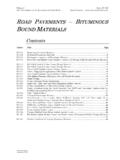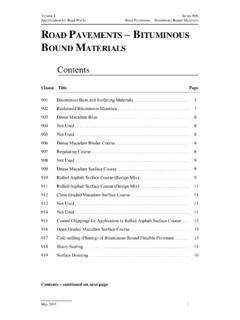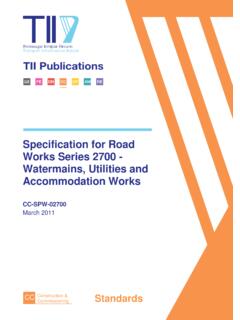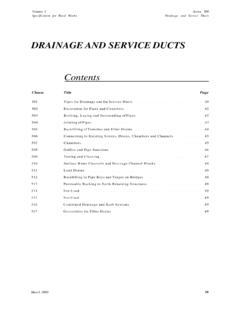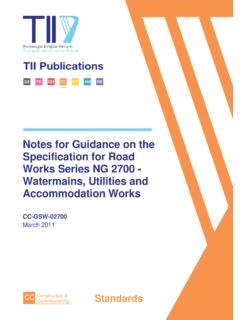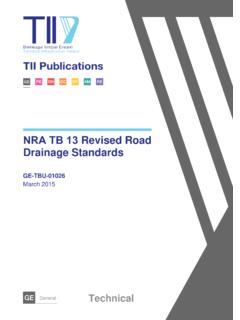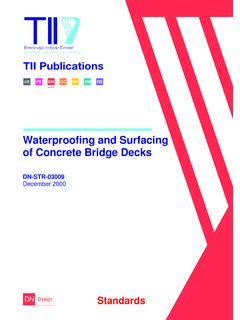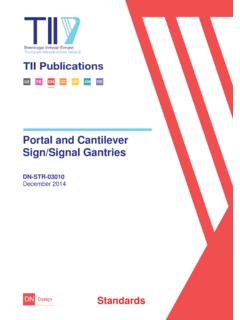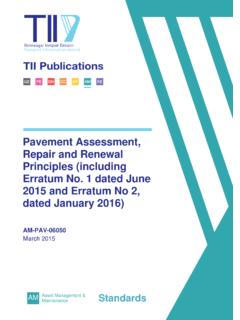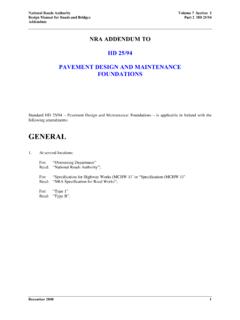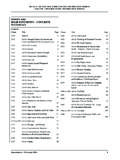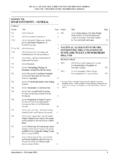Transcription of Road Pavements - Concrete and Cement Bound …
1 Volume 2 series NG 1000 Notes for Guidance on the Specification for road Works road Pavements - Concrete and Cement Bound Materials road Pavements - Concrete and Cement Bound Materials NG 1001 Grades and Constituents of Concrete 1 Clauses 1001 and 1002 give the requirements for materials and limits for mix proportions for designed Concrete mixes in the form required in BS 5328. 2 In addition to Portland Cement (PC) the term ' Cement ' includes blends of PC and pulverised-fuel ash (PFA,), whether they are blended on site or manufactured by blending or intergrinding.
2 3 For durability it is necessary to have a water/ Cement ratio below for a pavement surface slab. The water/ Cement ratio is defined as the ratio of free water to total Cement content of the mix. 4 PC/PFA Concrete has a long term increase in strength greater than PC concretes for the same 28-day strength and provide greater durability and resistance to chemical attack. If PFA is included in the mix it permits lower water/ Cement ratios for a required workability, so providing denser Concrete of lower perme-ability and greater durability. Admixtures 5 Air entraining agents are essential in pave-ment surface slabs to reduce permeability and frost damage.
3 They also have a plasticising effect. They are not necessary in roadbase Concrete unless the Concrete is to be exposed to frost before the surfacing is applied. A small loss in strength is to be expected with air entrained Concrete compared with plain Concrete with the same mix proportions. 6 Plasticisers can be used to reduce water in the mix, increase strength and maintain work-ability at the required level. They can be beneficial in mixes with blends of PC with PFA, as the water reduction partially compen-sates for the loss of early strength.
4 7 Where low water/ Cement ratios are used to obtain C40 strength, retarders can be used in high summer temperatures, to ensure that the finishing processes can be completed in time. Aggregates 8 The maximum size of aggregate allowed is 40 mm, but the Contractor's choice of size will depend on construction methods, and his ability to achieve surface regularity, properly constructed joints and correct alignment of dowels. Larger aggregate provides an advan-tage in producing a more stable Concrete in the lower layer, while 20 mm aggregate is preferable in the top course for forming joints and achieving a good finish.
5 9 Popouts can occur in the surface of the Concrete slab when frost-susceptible particles are included in the aggregate. If there is a sufficient proportion of such particles this can lead to 'D' cracking which is a form of cracking caused by expansion due to frost, close to transverse and longitudinal joints. 10 The use of aggregate with high water absorption values is not desirable. In addition to frost damage due to absorption of water there is a higher risk of alkali silica reaction in the presence of moisture in the porous aggregates.
6 Details of the required tests should be scheduled in Appendix 1/5. 11 The soundness test should be used for source approval for aggregates, the durability of which the Engineer considers questionable. It is not intended as a mandatory test for known durable aggregates. The water absorption test can be used as a routine check test of such aggregates. NG 1003 Density 1 Density is required to be measured at regular intervals during paving as well as the trial length. Until nuclear density meters are proven as acceptable for plastic Concrete , cores will be required to be cut.
7 Lb prevent undue damage to the slabs, cores should not be taken at points of high stress such as corners of slabs. The most desirable position for taking cores for routine density and inspection checks is as follows: (i) Between quarter points along the slab. (ii) Within m of any longitudinal joint in a hard shoulder, hard strip or the least trafficked lane of the section being inspected. 2 Where cores contain tie bars or other reinforce-ment, allowance for the amount of steel should be made in any calculation of the density of the Concrete . March 2000 142 Volume 2 series NG 1000 Notes for Guidance on the Specification for road Works road Pavements - Concrete and Cement Bound Materials 3 As a rough rule for assessment of strength, 1% reduction in density equates to a 5% loss of strength of Concrete .
8 4 Calculation of the theoretical maximum dry density (TMDD) of the Concrete , for comparison with cores, should take into account the Bound water due to the hydration of the Cement . This will vary with the age of the Concrete . In calculating the TMDD the mass of hydrated Cement is found by multiplying the mass of Cement in the fresh Cement mix by a time factor (F) determined from the following Table NG 10/1. Table NG 10/1: Time Factor (F) for Hydrated Cements and Cement Blends Age (Days) PC PC/PFA 1-3 >3-7 > 7-91 > 91-365 The theoretical maximum dry density (TMDD) of the Concrete shall be calculated from the formula: TMDD = [(FxW'i + W' + W'Jx 1000 ~w w4 w + + + wa pi JJ4 Where: F = W' = W- = W* = W4 = P' = F = P4 = Note.)]
9 Time factor for hydration of Cement from Table NG 10/1 mass of Cement (kg) mass of total water (in aggregate + added)(kg) mass of oven-dry fine aggregate (kg) mass of oven-dry coarse aggregate (kg) relative density of Cement apparent relative density of fine aggregate apparent relative density of coarse aggregate (i) The apparent relative density and moisture content shall be determined in accordance with the method described in BS 812 : Part 2. (ii) Where more than one size of coarse aggregate is used then: W' = W' + W- + W' + W" and W4 W" p. Wh p., w< p + .. W" P" Where W" is the mass of oven-dry aggregate of a certain fraction and Pn is the apparent relative density of that certain fraction.
10 (iii) Where blends of PC and PFA are used then: W1 = W + W" and W1 P' W" p where suffix values of W" pP = PC " = PFA P = Pp = are recommended Table NG 10/2 gives a worked example of the determination of the theoretical maximum dry density (TMDD). NG 1004 Quality Control of Concrete Strength 1 BS 5328 : Part 4 is used as the basis for control testing of pavement Concrete but the rate of sampling and testing has been modified. 2 The 7-day strengths are used to give early warning of the possibility of low results and any need for additional Cement after 7 days can be verified by the test results at 28 days.
